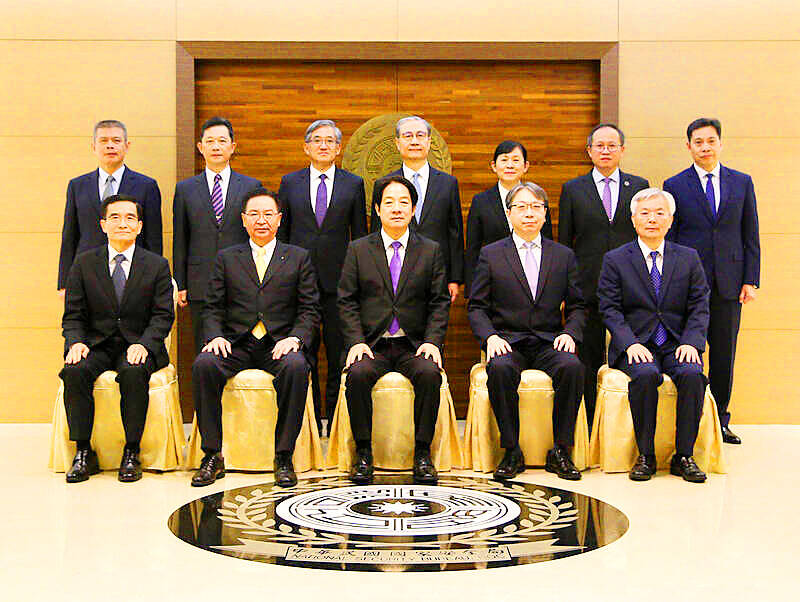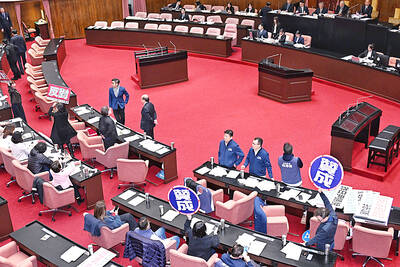The National Security Council (NSC) has published its information security strategy for this year, which includes establishing a national center to monitor security risks and outlines three major goals for enhancing the nation’s critical infrastructure security.
The council’s strategy highlights the importance of protecting critical infrastructure — including water, electricity, communications, transportation, finance and healthcare systems — from cyberthreats.
Disruptions to these systems caused by cyberattacks could paralyze society, severely impact the economy, jeopardize public safety and disrupt daily life, the NSC said. Such incidents would also erode public trust in the government and threaten national stability.

Photo coutesy of the National Security Bureau
The strategy emphasizes that information security is crucial in safeguarding the military’s operational command system, ensuring that facilities, equipment, communications and decision-making processes remain free from external interference.
Information security is a critical extension of national defense and military strategy, the council said.
The military must be able to counter cyberattacks to prevent adversaries from compromising defense systems, stealing sensitive information or crippling operational capabilities, the council said.
Homeland security and the protection of critical infrastructure constitute one of the strategy’s four central pillars, supported by three primary objectives.
The first objective is to conduct comprehensive assessments of potential information security risks and develop countermeasures to bolster critical infrastructure protection and defense readiness.
The second aims to strengthen national defense, public welfare, disaster preparedness and democratic resilience through robust regulation and enforcement of cybersecurity standards.
The third objective is to enhance information security preparedness to safeguard national security and ensure regional peace and stability.
As a concrete step, the strategy calls for the establishment of a national information security center to monitor nation-level security risks. The center would bolster interagency coordination and response mechanisms, ensuring that resources can be rapidly mobilized to address major cybersecurity incidents, it said.
The strategy also said the government should clearly define information security objectives and requirements for defense and law enforcement agencies, and recommends prioritizing the allocation of resources toward intelligence gathering, threat analysis, and the development of proactive defense capabilities.
In addition, the strategy recommends that the government conduct a comprehensive inventory of key agencies and critical infrastructure facilities, categorize them by risk level, and regularly review them to ensure compliance with security regulations.
It also calls for stronger oversight of critical infrastructure facilities, enforcement of incident investigation and accountability mechanisms, and the assurance that all agencies meet established information security standards.
National security and information security agencies should work with critical infrastructure operators to implement a comprehensive action plan aimed at enhancing network resilience, it said.
The strategy also urges the establishment of an interagency coordination platform to strengthen operational resilience during emergencies.
Furthermore, it proposes the creation of a dedicated information security protection team to be able to rapidly respond to emergencies involving critical infrastructure.
Third-party information security drills and tabletop exercises should be established to test and verify information security defense and response mechanisms, it said.

A car bomb killed a senior Russian general in southern Moscow yesterday morning, the latest high-profile army figure to be blown up in a blast that came just hours after Russian and Ukrainian delegates held separate talks in Miami on a plan to end the war. Kyiv has not commented on the incident, but Russian investigators said they were probing whether the blast was “linked” to “Ukrainian special forces.” The attack was similar to other assassinations of generals and pro-war figures that have either been claimed, or are widely believed to have been orchestrated, by Ukraine. Russian Lieutenant General Fanil Sarvarov, 56, head

SAFETY FIRST: Double the number of police were deployed at the Taipei Marathon, while other cities released plans to bolster public event safety Authorities across Taiwan have stepped up security measures ahead of Christmas and New Year events, following a knife and smoke bomb attack in Taipei on Friday that left four people dead and 11 injured. In a bid to prevent potential copycat incidents, police deployments have been expanded for large gatherings, transport hubs, and other crowded public spaces, according to official statements from police and city authorities. Taipei Mayor Chiang Wan-an (蔣萬安) said the city has “comprehensively raised security readiness” in crowded areas, increased police deployments with armed officers, and intensified patrols during weekends and nighttime hours. For large-scale events, security checkpoints and explosives

‘POLITICAL GAME’: DPP lawmakers said the motion would not meet the legislative threshold needed, and accused the KMT and the TPP of trivializing the Constitution The Legislative Yuan yesterday approved a motion to initiate impeachment proceedings against President William Lai (賴清德), saying he had undermined Taiwan’s constitutional order and democracy. The motion was approved 61-50 by lawmakers from the main opposition Chinese Nationalist Party (KMT) and the smaller Taiwan People’s Party (TPP), who together hold a legislative majority. Under the motion, a roll call vote for impeachment would be held on May 19 next year, after various hearings are held and Lai is given the chance to defend himself. The move came after Lai on Monday last week did not promulgate an amendment passed by the legislature that

PENTAGON ASSESSMENT: A US report said that even as China and Russia deepen their partnership, cooperation is hindered by a ‘mutual distrust’ of each other The Chinese People’s Liberation Army (PLA) as of October had doubled the number of ships and airplanes deployed around Taiwan compared with the previous two years, Vice Minister of National Defense Hsu Szu-chien (徐斯儉) said yesterday, a day after the opposition-controlled legislature voted against reviewing the government’s general budget for next year, including a NT$1.25 trillion (US$39.71 billion) special defense spending bill. The legislature’s vote against the Ministry of National Defense’s spending plans was regrettable, as the budget was designed to respond to the developing Chinese military threat, Hsu said on the sidelines of a legislative meeting on the general budget. Defense